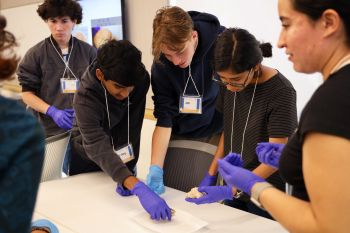Authors: Maud Hensums is a PhD candidate at the University of Amsterdam. Her research focuses on how peers and social norms influence adolescent behavior. Eddie Brummelman is an assistant professor at the University of Amsterdam and former Marie Skłodowska-Curie Fellow at Stanford University. He studies the origins and nature of children’s self-views, such as narcissism and self-esteem.
We believe it is time to reconsider our view of teens during COVID-19: Teens are not the problem, they are part of the solution.
Why are teens part of the solution? Even more so than adults, teens are idealists, who believe in making the world a better place for themselves and others. Teens successfully inspired many social movements. High-school students across the U.S. have organized public marches for Black Lives Matter. Greta Thunberg addressed world leaders on climate change at the World Economic Forum in Davos. Students from the Parkland, Florida, high school where 17 of their peers and teachers were shot and killed in 2018 started the #NeverAgain movement against gun violence at schools.
How can teens help fight COVID-19? They can do so by spreading social norms that encourage responsible behaviors: social distancing, wearing a face mask, and self-quarantining after exposure. Social norms are socially shared definitions of the way people do behave or should behave, and they spread rapidly through social networks. Social norms are particularly important during the teenage years, as teens are highly sensitive to social evaluation; they readily conform to peer norms to earn the respect of their peers.
Teens can spread social norms, for example, by modeling responsible behaviors and praising such behaviors in others, both in real life and on social media. To inspire change in others, teens can emphasize their similarity to others and articulate clear goals with expected outcomes. Teens can do so, for example, by posting a photo of themselves wearing a face mask in public, and adding a hashtag that explains why they did so: #protectingmyfriends. Indeed, other teens are more likely to follow social norms when they feel similar to the person introducing these norms, and when they know what these norms intend to achieve.
Such initiatives have proven effective, both in research and in real life. For example, teen influencer Millie Bobby Brown joined the ‘I stay home for…’ challenge on Instagram. Posting a photo of herself at home in her pajamas, she told her followers that she stays home to protect her loved ones: “My beautiful nan, she protected me my whole life, now it’s time for me to protect her.” Her message inspired change in many of her 38 million followers.
Of course, not all teens have millions of followers. To be sure, smaller-scale initiatives can be even more successful in inspiring change in local communities. Indeed, all teens are part of social networks, and many can activate their networks via social media to help beat the pandemic.
As parents, teachers, or researchers, we have the responsibility to support teens to become change makers. We can do so by providing teens with the time and resources they need to start teen-led initiatives. Doing so, we should accord them with respect and cultivate their sense of autonomy. Whenever we can, we should help their initiatives become visible or even go viral via newspapers, blogs, or social media. Teens have the power but we can help them get started, working towards the common goal of beating the pandemic.



_350_233_80_c1.jpg)